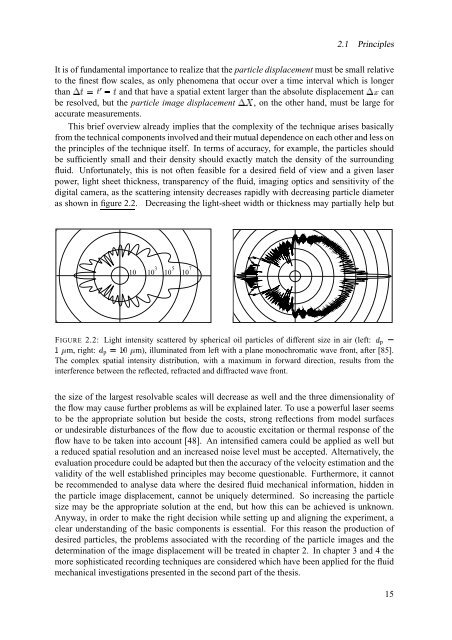The significance of coherent flow structures for the turbulent mixing ...
The significance of coherent flow structures for the turbulent mixing ...
The significance of coherent flow structures for the turbulent mixing ...
You also want an ePaper? Increase the reach of your titles
YUMPU automatically turns print PDFs into web optimized ePapers that Google loves.
2.1 Principles<br />
It is <strong>of</strong> fundamental importance to realize that <strong>the</strong> particle displacement must be small relative<br />
to <strong>the</strong> finest <strong>flow</strong> scales, as only phenomena that occur over a time interval which is longer<br />
than<br />
mand that have a spatial extent larger than <strong>the</strong> absolute displacement can<br />
be resolved, but <strong>the</strong> particle image displacement , on <strong>the</strong> o<strong>the</strong>r hand, must be large <strong>for</strong><br />
accurate measurements.<br />
This brief overview already implies that <strong>the</strong> complexity <strong>of</strong> <strong>the</strong> technique arises basically<br />
from <strong>the</strong> technical components involved and <strong>the</strong>ir mutual dependence on each o<strong>the</strong>r and less on<br />
<strong>the</strong> principles <strong>of</strong> <strong>the</strong> technique itself. In terms <strong>of</strong> accuracy, <strong>for</strong> example, <strong>the</strong> particles should<br />
¢md£€mob ¢¡<br />
be sufficiently small and <strong>the</strong>ir density should exactly match <strong>the</strong> density <strong>of</strong> <strong>the</strong> surrounding<br />
hu<br />
fluid. Un<strong>for</strong>tunately, this is not <strong>of</strong>ten feasible <strong>for</strong> a desired field <strong>of</strong> view and a given laser<br />
power, light sheet thickness, transparency <strong>of</strong> <strong>the</strong> fluid, imaging optics and sensitivity <strong>of</strong> <strong>the</strong><br />
digital camera, as <strong>the</strong> scattering intensity decreases rapidly with decreasing particle diameter<br />
as shown in figure 2.2. Decreasing <strong>the</strong> light-sheet width or thickness may partially help but<br />
Light<br />
3 5 Light<br />
10 10 10 10 7<br />
0 o 180 o 0 o 180 o<br />
FIGURE 2.2: Light intensity scattered by spherical oil particles <strong>of</strong> different size in air (left:<br />
ƒ…„m, ƒa†„m), right: illuminated from left with a plane monochromatic wave front, after [85].<br />
<strong>The</strong> complex spatial intensity distribution, with a maximum in <strong>for</strong>ward direction, results from <strong>the</strong><br />
interference between <strong>the</strong> reflected, refracted and diffracted wave front.<br />
p‚ p‚<br />
<strong>the</strong> size <strong>of</strong> <strong>the</strong> largest resolvable scales will decrease as well and <strong>the</strong> three dimensionality <strong>of</strong><br />
<strong>the</strong> <strong>flow</strong> may cause fur<strong>the</strong>r problems as will be explained later. To use a powerful laser seems<br />
to be <strong>the</strong> appropriate solution but beside <strong>the</strong> costs, strong reflections from model surfaces<br />
or undesirable disturbances <strong>of</strong> <strong>the</strong> <strong>flow</strong> due to acoustic excitation or <strong>the</strong>rmal response <strong>of</strong> <strong>the</strong><br />
<strong>flow</strong> have to be taken into account [48]. An intensified camera could be applied as well but<br />
a reduced spatial resolution and an increased noise level must be accepted. Alternatively, <strong>the</strong><br />
evaluation procedure could be adapted but <strong>the</strong>n <strong>the</strong> accuracy <strong>of</strong> <strong>the</strong> velocity estimation and <strong>the</strong><br />
validity <strong>of</strong> <strong>the</strong> well established principles may become questionable. Fur<strong>the</strong>rmore, it cannot<br />
be recommended to analyse data where <strong>the</strong> desired fluid mechanical in<strong>for</strong>mation, hidden in<br />
<strong>the</strong> particle image displacement, cannot be uniquely determined. So increasing <strong>the</strong> particle<br />
size may be <strong>the</strong> appropriate solution at <strong>the</strong> end, but how this can be achieved is unknown.<br />
Anyway, in order to make <strong>the</strong> right decision while setting up and aligning <strong>the</strong> experiment, a<br />
clear understanding <strong>of</strong> <strong>the</strong> basic components is essential. For this reason <strong>the</strong> production <strong>of</strong><br />
desired particles, <strong>the</strong> problems associated with <strong>the</strong> recording <strong>of</strong> <strong>the</strong> particle images and <strong>the</strong><br />
determination <strong>of</strong> <strong>the</strong> image displacement will be treated in chapter 2. In chapter 3 and 4 <strong>the</strong><br />
more sophisticated recording techniques are considered which have been applied <strong>for</strong> <strong>the</strong> fluid<br />
mechanical investigations presented in <strong>the</strong> second part <strong>of</strong> <strong>the</strong> <strong>the</strong>sis.<br />
15
















